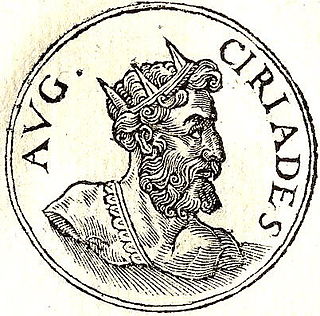
Appius Claudius Censorinus [1] was a fictional [2] usurper against Roman Emperor Claudius II, (in ca AD 269) according to the unreliable Historia Augusta . He is included in the list of the Thirty Tyrants.
Roman usurpers were individuals or groups of individuals who obtained or tried to obtain power by force and without legitimate legal authority. Usurpation was endemic during the Roman imperial era, especially from the crisis of the third century onwards, when political instability became the rule.
It is claimed that he had a lengthy career, having served twice as a consul, twice as a praetorian prefect, thrice as a praefectus urbi, and four times as a proconsul. He served under Valerian in the Roman–Persian Wars and was wounded in combat. His wounds forced him to retire from military service. He was already an old man and long retired when the troops of Bononia revolted and proclaimed him an Augustus. He was killed by his own soldiers, because he enforced too strict discipline. His reign lasted only a few days. [1]
A consul held the highest elected political office of the Roman Republic, and ancient Romans considered the consulship the highest level of the cursus honorum.
The praetorian prefect was a high office in the Roman Empire. Originating as the commander of the Praetorian Guard, the office gradually acquired extensive legal and administrative functions, with its holders becoming the Emperor's chief aides. Under Constantine I, the office was much reduced in power and transformed into a purely civilian administrative post, while under his successors, territorially-defined praetorian prefectures emerged as the highest-level administrative division of the Empire. The prefects again functioned as the chief ministers of the state, with many laws addressed to them by name. In this role, praetorian prefects continued to be appointed by the Eastern Roman Empire until the reign of Heraclius in the 7th century AD, when wide-ranging reforms reduced their power and converted them to mere overseers of provincial administration. The last traces of the prefecture disappeared in the Byzantine Empire by the 840s.

The praefectus urbanus, also called praefectus urbi or urban prefect in English, was prefect of the city of Rome, and later also of Constantinople. The office originated under the Roman kings, continued during the Republic and Empire, and held high importance in late Antiquity. The office survived the collapse of the Western Roman Empire, and the last urban prefect of Rome, named Iohannes, is attested in 599. In the East, in Constantinople, the office survived until the 13th century.
The entire account is a fabrication. [3] His name and career are meant to reflect traditional Roman values, and may form part of the author's agenda when he wrote the Historia Augusta. [4]
Francisco Mediobarbo Birago, a 17th-century numismatist, reported the existence of a coin commemorating the 3rd year of Censorinus' reign. The lack of sources for such a coin make it likely that it was a forgery of some kind. [1] Louis-Sébastien Le Nain de Tillemont suggested that Censorinus and Victorinus could be the same person. [1]
Numismatics is the study or collection of currency, including coins, tokens, paper money and related objects. While numismatists are often characterised as students or collectors of coins, the discipline also includes the broader study of money and other payment media used to resolve debts and the exchange of goods. Early money used by people is referred to as "Odd and Curious", but the use of other goods in barter exchange is excluded, even where used as a circulating currency. The Kyrgyz people used horses as the principal currency unit and gave small change in lambskins; the lambskins may be suitable for numismatic study, but the horses are not. Many objects have been used for centuries, such as cowry shells, precious metals, cocoa beans, large stones and gems.
Louis-Sébastien Le Nain de Tillemont was a French ecclesiastical historian.

Marcus Piavonius Victorinus was emperor in the Gallic provinces from 268 to 270 or 269 to 271, following the brief reign of Marius. He was murdered by a jealous husband whose wife he tried to seduce.













